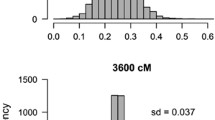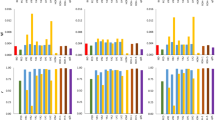Abstract
Inbreeding depression is a key factor affecting the persistence of natural populations, particularly when they are fragmented. In species with mixed mating systems, inbreeding depression can be estimated at the population level by regressing the average progeny fitness by the selfing rate of their mothers. We applied this method using simulated populations to investigate how population genetic parameters can affect the detection power of inbreeding depression. We simulated individual selfing rates and genetic loads from which we computed fitness values. The regression method yielded high statistical power, inbreeding depression being detected as significant (5 % level) in 92 % of the simulations. High individual variation in selfing rate and high mean genetic load led to better detection of inbreeding depression while high among-individual variation in genetic load made it more difficult to detect inbreeding depression. For a constant sampling effort, increasing the number of progenies while decreasing the number of individuals per progeny enhanced the detection power of inbreeding depression. We discuss the implication of among-mother variability of genetic load and selfing rate on inbreeding depression studies.




Similar content being viewed by others
References
Balloux F, Amos W, Coulson T (2004) Does heterozygosity estimate inbreeding in real populations. Mol Ecol 13:3021–3031
Barett S, Charlesworth D (1991) Effects of a change in the level of inbreeding on the genetic load. Nature 352(6335):522–524
Bijlsma R, Bundgaard J, Boerema AC (2000) Does inbreeding depression affect the extinction risk of small populations ?: predictions from Drosophila. J Evol Biol 13:502–514
Britten HB (1996) Meta-analyses of the association between multilocus heterozygosity and fitness. Evolution 50(6):2158–2164
Brook BW, Tonkyn DW, O’Grady JJ, Frankham R (2002) Contribution of inbreeding to extinction risk in threatened species. Conserv Ecol 6(1):Article No 16
Burczyk J, Kosiński G, Lewandowski A (1991) Mating pattern and empty seed formation in relation to crown level Larix decidua mill. clones. Silva fennica 25(4):201–205
Charlesworth D, Charlesworth B (1987) Inbreeding depression and its evolutionary consequences. Annu Rev Ecol Syst 18:237–268
Cheptou PO, Mathias A (2001) Can varying inbreeding depression select for intermediary selfing rates. Am Nat 157(4):361–373
Cheptou PO, Berger A, Blanchard A, Collin C, Escarre J (2000) The effect of drought stress on inbreeding depression in four populations of the mediterranean outcrossing plant Crepis sancta (asteraceae). Heredity 85:294–302
Cheptou PO, Imbert E, Lepart J, Escarre J (2000) Effects of compettition on lifetime estimates of inbreeding depression in the outcrossing plant Crepis sancta (asteraceae). J Evol Biol 13:522–531
Culley TM, Weller SG, Sakai AK, Rankin AE (1999) Inbreeding depression and selfing rates in a self-compatible, hermaphroditic species, Schiedea membranacea (caryophyllaceae). Am J Bot 86(7):980–987
Darwin CR (1876) The effects of cross and self-fertilisation in the vegetable kingdom. John Murray, London
Dudash MR, Fenster CB (2001) The role of breeding system and inbreeding depression in the maintenance of an outcrossing mating strategy in Silene virginica (Caryophyllaceae. Am J Bot 88(11):1953–1959
Ellstrand NC, Elam DR (1993) Population genetic consequences of small population size: implications for plant conservation. Annu Rev Ecol Syst 24:217–242
Eppley SM, Pannell JR (2007) Density-dependent self-fertilization and male versus hermaphrodite siring success in an androdioecious plant. Evolution 61(10):2349–2359
Ferriol M, Pichot C, Lefèvre F (2011) Variation of selfing rate and inbreeding depression among individuals and across generations within an admixed Cedrus population. Heredity 106:146–157
Glémin S (2003) How are deleterious mutations purged? Drift versus non-random mating. Evolution 57(12):2678–2687
Goodwillie C, Knight MC (2006) Inbreeding depression and mixed mating system in Leptosiphon jepsonii: a comparison of three populations. Ann Bot 98:351–360
Goodwillie C, Kalisz S, Eckert CG (2005) The evolutionary enigma of mixed mating systems in plants: occurence, theoretical explanations, and empirical evidence. Annu Rev Ecol Evol Syst 36:47–79
Grueber CE, Wallis GP, Jamieson IG (2008) Heterozygosity-fitness correlations and their relevance to studies on inbreeding depression in the threatened species. Mol Ecol 17:3978–3984
Grueber CE, Waters JM, Jamieson IG (2011) The imprecision of heterozygosity-fitness correlations hinders the detection of inbreeding and inbreeding depression in a threatened species. Mol Ecol 20:67–79
Hedrick PW (2004) Recent developments in conservation genetics. For Ecol Manag 197:3–19
Hedrick PW, Kalinowski ST (2000) Inbreeding depression in conservation biology. Annu Rev Ecol Syst 31:139–162
Hedrick PW, Savolainen O, Kärkkäinen K (1999) Factors influencing the extent of inbreeding depression: an example from scots pine. Heredity 82:441–450
Husband BC, Schemske DW (1996) Evolution of the magnitude and timing of inbreeding depression in plants. Evolution 50(1):54–70
Jacquard A (1975) Inbreeding: oneword, severalmeanings. Theor Popul Biol 7:338–363
Jain SK (1976) The evolution of inbreeding in plants. Annu Rev Ecol Syst 7:469–495
Keller LF, Waller DM (2002) Inbreeding effects in wild populations. Trends Ecol Evol 17(5):230–241
Keller LF, Grant PR, Grant BR, Petren K (2002) Environmental conditions affect the magnitude of inbreeding depression in survival of darwin’s finches. Evolution 56(6):1229–1239
Kormutak A, Lindgren D (1996) Mating system and empty seeds in silver fir (Abies alba mill.). For Genet 3(4):231–235
Lande R, Schemske DW (1985) The evolution of self-fertilization and inbreeding depression in plants. i.genetic models. Evolution 39(1):24–40
Lascoux M, Lee JK (1998) One step beyond lethal equivalents: characterization of deleterious loci in the rapid cycling Brassica rapa l. population. Genetica 104:161–170
Lindgren D (1975) The relationship between self-fertilization, empty seeds and seeds originating from selfing as a consequence of polyembryony. Studia Forestalia Suecica 126:1–24
Lu Y (2000) Effects of density on mixed mating systems and reproduction in natural populations of Impatiens capensis. Int J Plant Sci 161(4):671–681
Luquet E, David P, Lena J, Joly P, Konecny L, Dufresnes C, Perrin N, Plenet S (2011) Heterozygosity-fitness correlations among wild populations of european tree frog (hyla arborea) detect fixation load. Mol Ecol 20:1877–1887
Maki M (1993) Outcrossing and fecundity advantage of females in gynodioecious Chionographis japonica var. kurohimensis (Liliaceae). Am J Bot 80(6):629–634
Mimura M, Aitken SN (2007) Increased selfing and decreased effective pollen donor number in peripheral relative to central populations in Picea sitchensis (pinaceae). Am J Bot 94(6):991–998
Morton NE, Crow JF, Muller HJ (1956) An estimate of the mutational damage in man from data on consanguineous marriages. Proc Nat Acad Sci 42:855–863
Naito Y, Kanzaki M, Iwata H, Obayashi K, Lee SL, Muhammad N, Okuda T, Tsumura Y (2008) Density-dependent selfing and its effects on seed performance in a tropical canopy tree species, Shorea acuminata (dipterocarpaceae). For Ecol Manag 256(3):375–383. doi:10.1016/j.foreco.2008.04.031
Pemberton J (2004) Measuring inbreeding depression in the wild: the old ways are the best. Trends Ecol Evol 19(12):613–615
R Development Core Team (2011) R: A language and environment for statistical computing. R Foundation for Statistical Computing, Vienna. URL http://www.R-project.org, ISBN 3-900051-07-0
Remington DL, O’Malley DM (2000) Whole-genome characterization of embryonic stage inbreeding depression in a selfed lobolly pine family. Genetics 155:337–348
Restoux G (2009) Variabilité spatio-temporelle de la reproduction chez une espèce pérenne monoïque : Le cas du sapin pectiné, abies alba miller, en limite sud de son aire de répartition. PhD thesis, Université Aix-Marseille III
Restoux G, Silva DE, Sagnard F, Torre F, Klein EK, Fady B (2008) Life at the margin: the mating system of mediterranean conifers. Web Ecol 8:94–102
Ritland K (1990) Inferences about inbreeding depression based on changes of the inbreeding coefficient. Evolution 44(5):1230–1241
Robertson A, Hill WG (1984) Deviations from hardy-weinberg proportions: Sampling variances and use in estimation of inbreeding coefficients. Genetics 107:703–718
Schemske DW, Lande R (1985) The evolution of self-fertilization and inbreeding depression in plants. ii. empirical observations. Evolution 39(1):41–52
Slate J, David P, Dodds K, Veenvliet B, Glass B, Broad T, McEwan J (2004) Understanding the relationship between the inbreeding coefficient and multilocus heterozygosity: theoretical expectations and empirical data. Heredity 93:255–265
Sorensen F (1969) Embryonic genetic load in coastal douglas-fir, Pseudotsuga menziesii var. menziesii. Am Nat 103(932):389–398
Sorensen FC (1982) The roles of polyembryony and embryo viability in the genetic system of conifers. Evolution 36(4):725–733
Szulkin M, Bierne N, David P (2010) Heterozygosity-fitness correlations: a time for reappraisal. Evolution 64(5):1202–1217
Wang KS (2003) Relationship between empty seed and genetic factors in european beech (Fagus sylvatica L.). Silva Fennica 37(4):419–428
Weir B, Cockerham C (1984) Estimating F-statistics for the analysis of population structure. Evolution 38(6):6
Weller SG, Sakai AK, Thai DA, Tom J, Rankin AE (2005) Inbreeding depression and heterosis in populations of Schiedea viscosa, a highly selfing species. J Evol Biol 18:1434–1444
Williams C, Barnes R, Nyoka I (1999) Embryonic genetic load of a neotropical conifer, Pinus patula schiede and deppe. J Hered 90(3):394–398
Williams CG, Savolainen O (1996) Inbreeding depression in conifers: implications for breeding strategy. For Sci 42(1):102–117
Winn AA, Elle E, Kalisz S, Cheptou PO, Eckert CG, Goodwillie C, Johnston MO, Moeller DA, Ree RH, Sargent RD, Vallejo-Marín M (2011) Analysis of inbreeding depression in mixed-mating plants provides evidence for selective interference and stable mixed mating. Evolution 65(12):3339–3359
Acknowledgments
Financial support to Gwendal Restoux during his Ph.D. was provided by INRA-EFPA and The Provence Alpes Côtes dAzur Regional Government. The study was partially funded by the European Network of Excellence EVOLTREE. The authors are grateful to Jacqui Shykoff for helpful comments on the manuscript.
Author information
Authors and Affiliations
Corresponding author
Electronic supplementary material
Below is the link to the electronic supplementary material.
Rights and permissions
About this article
Cite this article
Restoux, G., Huot de Longchamp, P., Fady, B. et al. Variability of individual genetic load: consequences for the detection of inbreeding depression. Genetica 140, 39–51 (2012). https://doi.org/10.1007/s10709-012-9656-7
Received:
Accepted:
Published:
Issue Date:
DOI: https://doi.org/10.1007/s10709-012-9656-7




